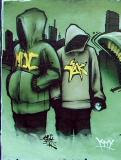
The robot is simply the illusion of being a robot. Movements of the robot are normally started and finished with a dimestop (a very abrupt stop), to give the impression of motors starting and stopping, but poppers have also been known to do the robot with a pop to the beat. As long as the illusion of being a robot is maintained, it is considered the robot.Robot dancing is often considered a subsection of popping because poppers often include the robot in their routines, sometimes adding pops to the beat while maintaining the illusion of a robot, but the robot also exists as its own dance and is sometimes considered a performance rather than a dance when the performer is imitating a robot without any music. When done without music it is considered to be mime, instead of dance. Street theater often featured mimes who did a mechanical man or puppet style illusion, without music. In the late 1960s the style was used while social dancing to funk or soul music. Charles "Robot" Washington was not the first to strictly imitate a robot as a mime however, he and his partner "Robot Ann" was the first to socially couple dance the style to music at parties and clubs, and it was at this point it became a party dance and later combined with other illusion styles to form todays popping style.




